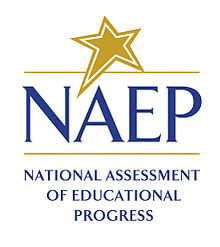 Global Information
Global InformationNational Assessment of Educational Progress information
This article relies excessively on references to primary sources. (December 2011) |


The National Assessment of Educational Progress (NAEP) is the largest continuing and nationally representative assessment of what U.S. students know and can do in various subjects. NAEP is a congressionally mandated project administered by the National Center for Education Statistics (NCES), within the Institute of Education Sciences (IES) of the United States Department of Education. The first national administration of NAEP occurred in 1969.[1] The National Assessment Governing Board (NAGB) is an independent, bipartisan board that sets policy for NAEP and is responsible for developing the framework and test specifications.The National Assessment Governing Board, whose members are appointed by the U.S. Secretary of Education, includes governors, state legislators, local and state school officials, educators, business representatives, and members of the general public. Congress created the 26-member Governing Board in 1988.
NAEP results are designed to provide group-level data on student achievement in various subjects, and are released as The Nation's Report Card.[2] There are no results for individual students, classrooms, or schools. NAEP reports results for different demographic groups, including gender, socioeconomic status, and race/ethnicity. Assessments are given most frequently in mathematics, reading, science and writing. Other subjects such as the arts, civics, economics, geography, technology and engineering literacy (TEL) and U.S. history are assessed periodically.
In addition to assessing student achievement in various subjects, NAEP also surveys students, teachers, and school administrators to help provide contextual information. Questions asking about participants' race or ethnicity, school attendance, and academic expectations help policy makers, researchers, and the general public better understand the assessment results.
Teachers, principals, parents, policymakers, and researchers all use NAEP results to assess student progress across the country and develop ways to improve education in the United States. NAEP has been providing data on student performance since 1969.[3][4]
NAEP uses a sampling procedure that allows the assessment to be representative of the geographical, racial, ethnic, and socioeconomic diversity of the schools and students in the United States.[citation needed] Data is also provided on students with disabilities and English language learners. NAEP assessments are administered to participating students using the same test booklets and procedures, except accommodations for students with disabilities,[5][6] so NAEP results are used for comparison of states and urban districts that participate in the assessment.
There are two NAEP websites: the NCES NAEP website and The Nation's Report Card website. The first site details the NAEP program holistically, while the second focuses primarily on the individual releases of data.
- ^ "History and Innovation - What is the Nation's Report Card | NAEP". nces.ed.gov. Retrieved 2022-04-05.
- ^ "Nation's report card".
- ^ Mullis, Ina V. S. (2019). White Paper on 50 Years of NAEP Use: Where NAEP Has Been and Where It Should Go Next (PDF) (Report). American Institutes for Research. Retrieved 2021-03-12.
- ^ Jones, Lyle V. (1996). "A history of the National Assessment of Educational Progress and some questions about its future". Educational Researcher. 25 (7): 15–22. doi:10.3102/0013189X025007015. JSTOR 1176519. S2CID 145442224. Retrieved 2021-03-12 – via JSTOR.
- ^ "Revised, November 2018 G ALLOWABLE ACCOMMODATIONS FOR STUDENTS WITH DISABILITIES" (PDF). gadoe.org. 2018-11-05.
- ^ Freedman, Miriam (2009-03-04). "NAEP and Testing Students with Disabilities and English Language Learners" (PDF). NAGB.